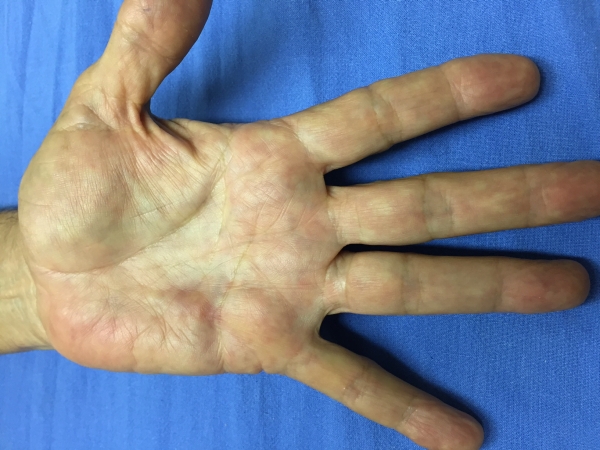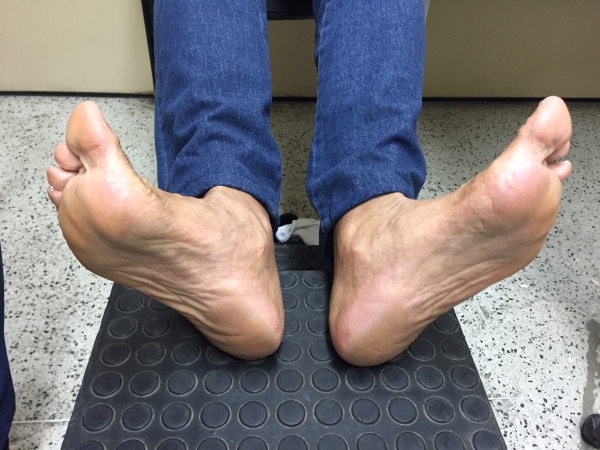Session Information
Date: Tuesday, June 21, 2016
Session Title: Tremor
Session Time: 12:30pm-2:00pm
Location: Exhibit Hall located in Hall B, Level 2
Objective: To present a case of Dupuytren’s contracture (DC), Ledderhose’s syndrome (LS), and Peyronie’s disease (PD) in a patient with long term use of primidone (PRM) for essential tremor (ET).
Background: Development of connective tissue disorders has been associated with antiepileptic drugs, especially with barbiturates¹. PRM is an anticonvulsant of the barbiturate class, a structural analog of phenobarbital, also used as first-line therapy for ET. DC is a benign, progressive fibroproliferative disorder of palmar fascia characterized by palmar nodules and digital flexion contracture. When the process affects the plantar fascia it is called LS, however it is much rarer. PD is a fibrotic disorder of the tunica albuginea causing varying degrees of penile deformity, pain, and erectile dysfunction².
Methods: Case report.
Results: A 71-year-old white man, followed at the Movement Disorders Clinic of a tertiary hospital in Rio de Janeiro, Brazil, complained of a six-month history of progressive contractures in his left hand and right foot. He had been using PRM 100 mg qd for 6 years due to ET, with good symptomatic control. He did not have any predisposing factors for fibromatosis. The patient reported discomfort to wear shoes and functional limitation in the left hand. When asked objectively about other symptoms, he revealed penile anatomical deformity for the previous 2 years. The fibrotic curvature was so pronounced that he could not have sex with his wife anymore. Physical examination revealed contracture of the left palmar and right plantar fasciae, as well as fibrotic curvature of the penis. The neurological examination was unremarkable, apart from a mild bilateral postural tremor. Ultrasonography confirmed the fibrotic deformities detected clinically. PRM was replaced by gabapentin and the patient was referred to experts for treatment of the connective tissue disorders.

Conclusions: The etiology of DC, LS, and PD remains unclear. Many studies have linked them to genetic factors, alcoholism, liver failure, diabetes mellitus, trauma, isoniazide, antiepileptic drugs, rheumatoid, and lupus arthritis. Our case reinforces the findings that chronic use of barbiturates can lead to fibroproliferative disorders. References: 1. Mattson RH, et al. Barbiturate-Related Connective Tissue Disorders. Arch Inter Med. 1989; 149:911-914. 2. Hatzimouratidis K, et al. European Association of Urology guidelines on penile curvature. Eur Urol. 2012 Sep; 62(3):543-52.
To cite this abstract in AMA style:
C.S.B. Germano, M. Spitz, L.F.R. Vasconcellos. Primidone-related connective tissue disorders in essential tremor [abstract]. Mov Disord. 2016; 31 (suppl 2). https://www.mdsabstracts.org/abstract/primidone-related-connective-tissue-disorders-in-essential-tremor/. Accessed April 1, 2025.« Back to 2016 International Congress
MDS Abstracts - https://www.mdsabstracts.org/abstract/primidone-related-connective-tissue-disorders-in-essential-tremor/
